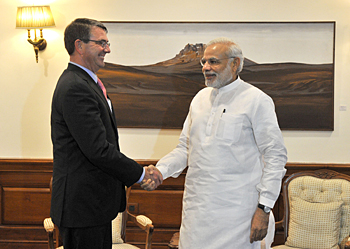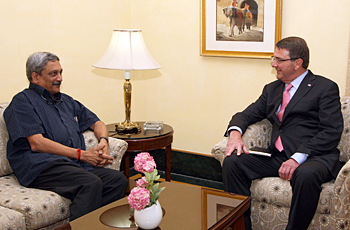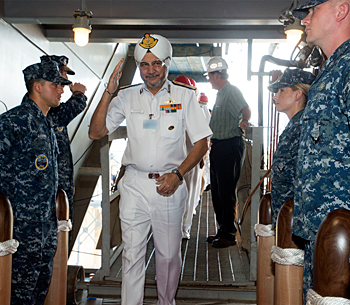INDIAN ARMED FORCES CHIEFS ON
OUR RELENTLESS AND FOCUSED PUBLISHING EFFORTS

SP Guide Publications puts forth a well compiled articulation of issues, pursuits and accomplishments of the Indian Army, over the years

I am confident that SP Guide Publications would continue to inform, inspire and influence.

My compliments to SP Guide Publications for informative and credible reportage on contemporary aerospace issues over the past six decades.
IRRC will fast track defence cooperation



In order to deepen defence relations with India, US administration has decided to clear all hurdles in its path by establishing a country specific cell called the India Rapid Reaction Cell (IRRC). This is considered as a signal to Indian defence establishments that all of its complaints will be addressed through this Cell, which will specifically deal with all the issues of export control related regimes in the US and ensure that these do not come in the way of increasing defence collaboration with India. The setting up of the defence cell is in fact a part of the various programmes under implementation to widen the scope of defence and strategic relations. These comprise the India-US Defence Trade and Technology Initiative (DTTI). The setting up of this cell is being seen as a mechanism to accelerate the process of co-development and co-production of advanced weapon systems with India.
According to senior defence officials, the setting up of this cell should be seen as a part of the US Strategic Military Guidance announced in January 2012 by President Obama who wants to lay greater emphasis on the Pacific region and refers to India as a Strategic Partner. Since both the countries have common interests in (1) Maintaining security and stability, (2) defeating violent religious extremism and terrorism, (3) preventing the spread of weapons of mass destruction and associated materials and (4) protecting the free flow of commerce and resources through the vital sea lanes of Indian Ocean, United States would like to strengthen India’s military capabilities to enable it to aid in US efforts to counter the Chinese aggression in the region.
While talking to the Indian wire service PTI in Washington DC, the Head of the IRRC Keith Webster said, “The purpose of the India Rapid Reaction Cell is to work all the initiatives that we have ongoing under the DTTI. Both the initiatives came out of the Joint Statement between the US President and Indian Prime Minister in New Delhi to move quickly and timely and be thorough which in my opinion requires dedicated support to ramp up the operational tempo.”
Diplomatic observers say that the current US Defence Secretary Ash Carter, who spearheaded the India-US Defence relations through the DTTI promoted by him, wanted a special mechanism in Pentagon to advance the DTTI. The IRRC will ascertain ways and means to transform the defence partnership without any bureaucratic hurdles. In fact the US administration wants the relations to move away from the traditional buyer-seller relationship to a more collaborative path. The IRRC will also explore new areas of technological collaboration and deepen the India-US business ties by widening the trade basket.
PTI reported from Washington that Pentagon has deployed seven senior officials in the Cell who represent various wings of the US Department of Defence. It is well known that DTTI was the brainchild of Ashton Carter, who is taking serious interest in expanding the bilateral defence relations. Through this initiative US has given a new dimension to India-US strategic partnership. When DTTI was set up, Carter was then a Deputy Secretary of Defence. DTTI also commands full respect from the Indian political leadership. The leaders of the two countries, during the Summit in January, 2015 had directed the two defence ministries to focus on pursuing the co-development pathfinder projects. The Pentagon and Indian MOD has also set up a joint US-India DTTI Interagency task force to review the progress in India-US Defence ties.
The Cell will be instrumental in fast forwarding the projects taken under the DTTI. The principal hurdle in advancing the India-US defence relations are the Foundational Agreements, which every country has to accept while importing US made defence equipments, systems and technology. The four foundational agreements are the Logistics Supply Agreement (LSA), Basic Exchange and Cooperation Agreement (BECA ), End-User agreement and Communications and Information Security Memorandum of Agreement (CISMOA). According to sources, the Defence Ministry of India had signed some of the agreements for import of defence systems and after an uproar in the Indian Parliament, refused to adhere to these agreements. The issue of India’s signature on the four foundational agreements have still not been sorted out and US officials insist that they are not making an issue of this in defence sales as they would still want India to adhere to these foundational agreements.
However to remove the barriers of International export control regimes, the US administration has already announced its support for India’s full membership of four regimes - the Nuclear Supplier Group, the Wassenar arrangement, the Missile Control Regime( MTCR) and the Australia Group, which would further facilitate technology sharing.
The cell would add to the other institutional mechanisms already working under the various Groups. These are - The Defence Policy Group (DPG) gives policy level direction to defence cooperation, reviews all matters and resolves broader defence cooperation policy issues. Various institutional mechanisms under the DPG which coordinate and implement defence cooperation in specific areas include: Defence Joint Working Group (DJWG) undertakes mid-year review of progress made in the fulfillment of decisions taken by the DPG. It also reviews matters, which need to be taken up by the DPG, Defence Procurement and Production Group (DPPG) reviews opportunities for cooperation in defence acquisition, transfer of technology/collaboration and defence related industries, Senior Technology Security Group (STSG) is charged with undertaking review of technology security issues and also — enhance mutual understanding of each other’s policies and systems in respect of technology security for defence-related equipment, Joint Technical Group (JTG) looks at potential for cooperation in defence research and development, Military Cooperation Group (MCG) reviews services related cooperation matters and inter-service coordination and Service-to-Service Executive Steering Groups (ESGs) review service-to-service cooperation and report to the Military Cooperation Group.
These close coordination at various levels have already led to over US$ 10 billion in defence sales to India over the last one decade. USA has thus emerged as a major rival to India’s traditional defence suppliers like Russia, Israel, France and Britain. Under the Pathfinder projects the two countries have decided to launch four pathfinder projects which are the — next generation Raven unmanned aerial vehicles (UAVs), roll-on roll-off intelligence gathering and reconnaissance modules for the C-130J Super-Hercules aircraft, mobile electric hybrid power sources and uniform integrated protection ensemble increment-2 (chemicaland biological warfare protection gear for the soldiers). The Raven is a hand held mini-drone, which is used by the soldiers in the battlefield to keep tabs on enemy formations within a range of 10 kms. The research establishments of the two sides plan to extend its range to 18kms and flying endurance from the existing four hours.
During the visit of President Obama to New Delhi, this Republic Day, he along with Modi promised that the DTTI would take the bilateral relationship to the new level. Both have indicated that new projects would be undertaken in the near future. The Defence establishments of the two sides gave the go-ahead for setting up the working groups to explore development of aircraft carrier technologies and jet engines. Definitely these joint projects would take the bilateral defence and strategic partnership to the new level. In the background of failed Indian efforts to develop the Kaveri Jet engine for the Light Combat Aircraft, this decision seems extremely significant.
Regarding Aircraft Carrier, India is already indigenously constructing the 40,000 ton displacement Aircraft Carrier INS Vikrant at Cochin shipyard. Another indigenous aircraft carrier of much bigger size and capacity is under consideration. The two sides have already held meetings on the electromagnetic aircraft launch systems — which will enable the fighters to take-off from the Carrier decks.
During the meeting of Indian and US experts held in USA in the second week of August, the two sides started discussion to jointly develop a next—generation aircraft carrier, which will bolster Indian Navy’s blue-water capabilities. The Indian delegation was led by Vice Admiral SPS Cheema, Flag Officer Commanding-in-Chief (FOC-in-C), Western Naval Command. He also visited the US Navy’s state of the art aircraft carrier — PCU Gerald Ford- which is under construction at Newport News Shipbuilding in Virginia. The US navy officers briefed him about the Aircraft Carrier Programmes. The Indian Navy delegation also met with senior Pentagon officials and toured the research and development facilities of the US Navy and explored opportunities for cooperation. Like the Indian Navy the US Navy has its own design team.
These developments along with the setting up of the IRRC promises a new era in Indo-US defence collaboration, which will naturally lead to a strong strategic partnership.





